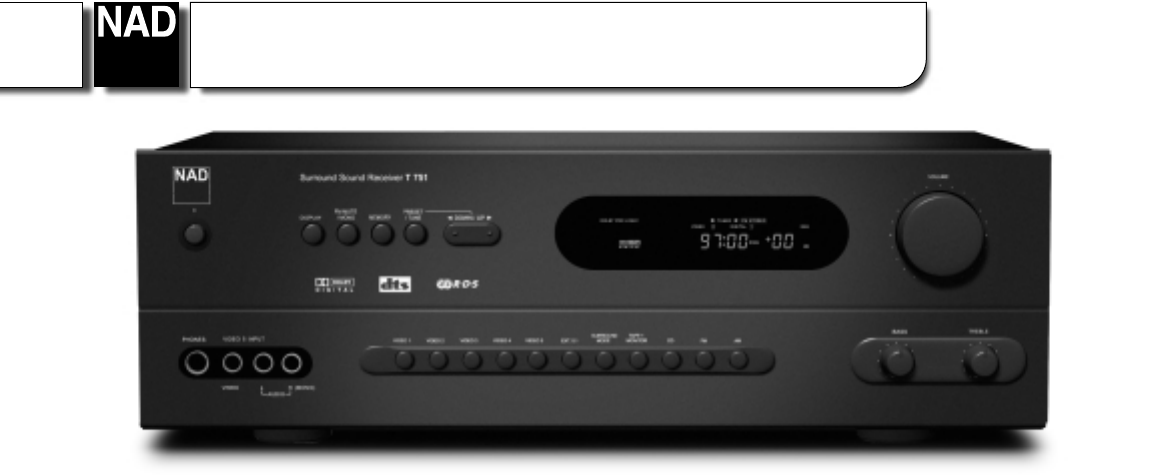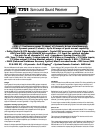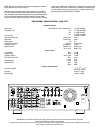
Ever since NAD entered the AV receiver market, the focus has always been on the audio
performance, unlike most other AV receivers that concentrate on features and impressive
specifications. The high praise that NAD AV receivers have gained underscores this
approach. After the initial excitement, people are starting to realise there is more than just
explosions, gunfights and car-crashes. An AV system also needs to faithfully reproduce
music, with or without pictures, stereo or multi-channel. The new NAD T751 continues
the NAD "music first" tradition with the T751, making it an ideal choice if you want your
system to perform well as a Surround and music system.
Design:
By doing away with many costly and superfluous features, NAD's engineers concentrated
only on the truly important parts of an A/V receiver. As the new Digital Surround Sound for-
mats allow for the same wide bandwidth and large dynamic range for the front channels as
the rear channels, all five channels are capable of putting out an equal amount of power.
As usual with NAD, the T751 uses discrete output stages only, including the surround chan-
nels. The benefits of this approach have been proven over the years in many acclaimed
NAD amplifiers and receivers. The integrated output modules favoured by so many other
designs will deliver a decent amount of power under laboratory conditions, driving an 8
ohms resistor, but can have great difficulties in driving moderately difficult speakers. The
NAD T751 uses the Impedance Sensing Circuitry (ISC) topology (patent pending) designed
by Bjørn Erik Edvardsen, now used to good effect in a large range of NAD products.
Impedance Sensing Circuitry
(ISC)
:
The ISC topology allows the T751 to deliver maximum performance under virtually any
circumstance, independent of the loudspeakers it is driving. The circuitry automatically
recognises the impedance characteristics of the loudspeaker and will then adjust its
power supply settings to best cope with that specific load.
NAD takes a stance to the mindless "brochure power" approach which doesn't give a real-
istic indication of an amplifier's true capabilities. Instead, the ISC topology is a practical
approach to enable an amplifier to easily deal with dynamics and difficult loads. More
meaningful are the T751's dynamic capabilities; up to 200 Watts into 2 ohms and up to
40 amps peak current capability.
Whereas it is widely accepted with CD players that the digital and analogue circuitry play a
vital role in the performance, it appears that many AV receivers employ only mediocre
Digital-to-Analogue (DAC), Analogue-to-Digital (ADC) converters and Digital Signal
Processors (DSP). For the T751 the engineers choose the best available within the bud-
get: Crystal Sigma-Delta DACs and ADCs, each with 24-bit resolution. The DSP chip that
handles the Dolby Digital, DTS, Dolby Pro Logic and EARS Modes, is also from the well
renowned manufacturer Crystal™. The combination of these components ensure that the
integrity of the original signal, be it music or an action movie, retains its full resolution
and dynamics.
Flexibility
As one would expect from any NAD component, the Model T751 offers great flexibility: the
5 video (1 on front panel for easy connection of game console or camcorder) and 2
audio inputs allow you to connect all your sources with ease. Three of the video inputs
are full S-Video and Composite compatible.
Besides these "normal" inputs, the T751 also sports an external decoder (5.1 channel)
input so you can easily expand your receiver in the future with an outboard decoder for
another surround sound format. 3 Digital inputs are provided, to cater for every eventuali-
ty: Two coaxial digital inputs and a TOS Link for sources with optical outputs. With pre-
amplifier outputs for all channels (Left, Centre, Right, Left Surround, Right Surround and
subwoofer) you can easily upgrade your output power too.
To ensure long-terms contact reliability, all speaker terminals are of the robust binding
post variety rather than the usual spring clips and all other audio sockets are gold plated.
Ease of use
Ease of use is another key factor for NAD products and the Model T751 is no exception.
The built-in Noise generator -accessible by remote control- allows for accurate calibrating
of the Front, Centre and Surround speakers.
The remote control handset supplied with the Model T751 also has controls for other
NAD components, such as CD players, for instance.
Thirty presets can be programmed at random with FM stations, ten with AM stations. The
T751 also offers RDS PS (Program Service) and RT (Radio Text). When tuning in to an
RDS radio station, the T751 will automatically display the name of the station so you do
not have to remember which frequency belongs to what station. At the touch of a button
T751 Surround Sound Receiver
• 60W x 5 Continuous power (8 ohms); all channels driven simultaneously
• 225W Dynamic power (2 ohms) • Up to 40 amps of peak current capability
• Dolby Digital & DTS decoder integrated • Crystal DSP processor • Crystal Sigma-Delta
ADCs and DACs with 96kHz/24 bit resolution • 5.1 input for external decoder
• Pre-outs for all channels (5.1 out) • Impedance Sensing Circuitry (ISC)
• CD; Tape; 5 Video inputs; 2 video outputs; all S-Video or Composite • 3 S-Video inputs;
1 S-Video output; S-Video Monitor output • 3 digital inputs; 2 RCA; 1 TOS Link
• EARS (Enhanced Ambience Recovery System) Music surround mode • RDS tuner (RDS
PS & RDS RT) • 30 presets • Soft Clipping
TM
• System Remote Control • NAD-Link




